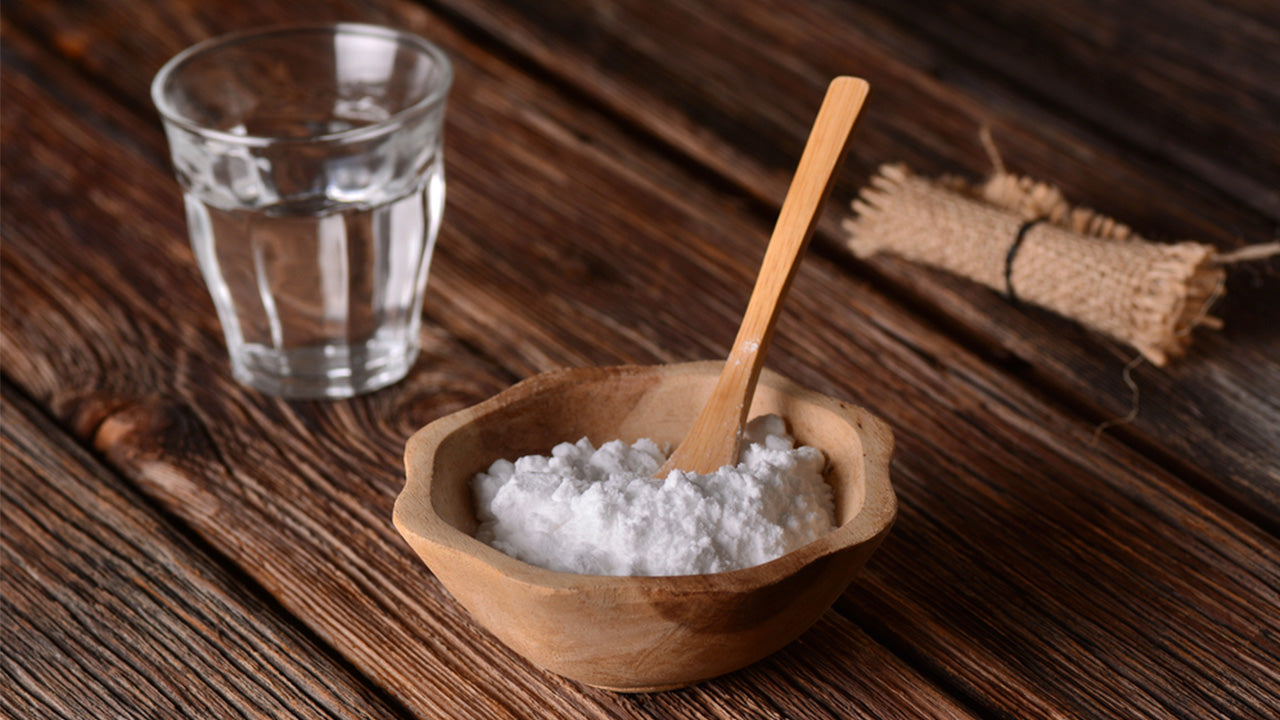Baking Soda Uses (Plus Is the Baking Soda Gender Test Myth, Magic or Medicine?)
 By: by Amino Science
By: by Amino Science

Baking soda is a multitasking household staple. Typically, baking soda is used for baking, cleaning, fighting acid reflux, and relieving skin rashes, but now social media gives it the power to reveal the gender of a child before it is born. Is the baking soda gender test a myth or proven fact? Let’s find out!
What Is Baking Soda?
Baking soda, or sodium bicarbonate, is an alkaline compound composed of sodium bicarbonate anion and sodium cation. Yes—it is technically a salt and in its unaltered form is known as the mineral nahcolite. In 1846 the New England company Church & Dwight started to manufacture bicarbonate soda known to consumers as aerated salt.
The product was quickly adopted in homes across the United States, and soon larger production facilities were required. Not long afterward, the Arm & Hammer brand was born and mass production began.
Fun fact—when Armand Hammer rose to prominence, he tired of being asked if he owned Arm & Hammer baking soda. Over the years, he bought stock in the company so he could answer "yes" to the question he was so often asked. In reality, baking soda was developed and used for over 30 years before Armand Hammer was born.
7 Baking Soda Uses in the Kitchen
Baking soda was likely first used in the kitchen in baking and food preparation. If you are looking for a baking soda substitute—sorry, there really is only one baking soda for baking. It may be tempting to substitute baking powder, but this will not leave you with pleasant results.
The differences of baking soda vs. baking powder are quite significant. Baking soda is the main ingredient in baking powder, but baking powder also contains cream of tartar (an acid) and cornstarch. This combination of ingredients totally changes the way it reacts to acid, liquids, and heat.
Today, in addition to giving baked goods their light and fluffy texture, baking soda is a time-saver in the kitchen.
1. Leavening Agent
Baking soda acts as a leavening agent in cakes, quick breads, muffins, griddled pancakes, and quick breads. Baking soda is the ingredient that gives batters their rise and structure. Unlike yeast, baking soda produces gas nearly instantly, so long proofing times are unnecessary.
When you are mixing baking soda into a recipe, you will notice bubbles starting to appear rather quickly. If you allow the batter to set on the countertop for more than a few minutes, the batter may overflow. It is best to bake or griddle recipes with baking soda as soon as possible after mixing.
2. Refrigerator Deodorizer
Baking soda absorbs odors quickly and contains the odors, which is why a box of baking soda is commonly found stashed in the back of refrigerators. You can also place an opened box in your freezer as well as in your pantry that houses fresh onions, garlic, and other aromatics to keep the odor down.
3. Microwave Cleaner
Does your microwave have splattered foods on the roof and sides? Baking soda can take care of that, and quickly. If the spatters have aged and are firmly attached to the surfaces of your microwave, the first step is to add some humidity to loosen the food's grip.
Fill half of a large microwave-safe bowl with fresh water and stir in 1 tablespoon of baking soda. Place in the microwave and set on medium-high heat for 3-4 minutes. Don't open the door. Let the bowl of water do its magic for 10 minutes. Open the door carefully and remove the bowl. Dip a sponge in the water and wipe down the microwave to remove the grime.
4. Cutting Board Stain Remover
If your cutting boards are stained, baking soda can help. Mix a couple of tablespoons of baking soda with 1 tablespoon of lemon juice and apply to the stain. Let it sit overnight and rinse.
5. Remedy a Clogged Drain
Did you accidentally put too much fat down your drain? You guessed it—baking soda to the rescue. For this baking soda use, we venture back to high school science class and basic chemical reaction. In addition to baking soda, you will need 1 cup or so of white vinegar.
Start this process by pouring a 1/2 cup of baking soda in the drain. Pour the vinegar on top and watch bubbles erupt. You should start to notice that foam becoming discolored, and it may possibly contain bits of food or other debris. When it quits foaming, run very hot water in the sink to flush out the clog.
6. Put out a Grease Fire
If you have a grease fire, never dowse it with water—this will cause it to explode and cause further damage. Instead, reach for your box of baking soda and sprinkle it over the flames, effectively suffocating the fire. Of course, whenever you see flames in your kitchen, call 911 immediately. As a warning—do not use baking soda on a fire caused by a deep fryer as it may cause the oil to overflow, leading to greater damage.
7. Kill Cockroaches
If you have a cockroach problem, use baking soda. Just sprinkle baking soda inside your cabinets, pantry, under your range, behind (and under) the refrigerator, and wherever else you see the roaches. Baking soda is a natural, nontoxic (to everyone but the cockroaches) roach killer that works by causing an extreme buildup of gas in the intestines of the cockroaches that results in their death.
Baking Soda Uses Around the House
When you step outside the kitchen, don’t forget to take your baking soda with you. Baking soda has disinfectant properties, raises pH levels, and is an excellent grout cleaner.
Grout Cleaner
If the grout in your bathroom, entryway, or kitchen has become filthy and stained, use equal parts baking soda and vinegar (or lemon juice) paste. The alkalinity of the baking soda reacts with the acidic nature of the vinegar or the lemon juice to quickly remove stubborn stains in your grout.
Mix the two ingredients thoroughly in a spray bottle and squirt over the tiles. Allow the mixture to set in for 5 to 10 minutes. It will fizz and bubble making the stubborn grime release. Use a grout brush or a toothbrush to release stubborn grit. Rinse thoroughly and then clean the entire floor with a mop.
Raise pH Levels in Pools and Spas
Baking soda is an excellent way to disinfect and control the pH and alkalinity levels in your pool or spa. And baking soda acts as a chlorine stabilizer and algae fighter. Monitor the pH levels in your pool or spa regularly and follow the guidelines provided by Arm & Hammer for best results.

Baking Soda Health Benefits
Baking soda is one of those compounds that every grandmother seemed to use for every ailment—and it worked. Today, baking soda health benefits are widely recognized. It is used to fight bacteria and fungi, to relieve heartburn, and to soothe the skin.
Relieve Heartburn and GERD Symptoms
The alkalinity of baking soda can relieve heartburn symptoms in just a few minutes. Baking soda is recognized as an effective and natural acid reflux remedy that works by restoring the gut’s natural pH balance by neutralizing the acid.
Soothe Canker Sores
According to the Mayo Clinic, you can speed healing and relieve canker sore pain with baking soda. Baking soda is an effective canker sore remedy and it only takes 1 teaspoon in 1/2 cup of warm water to start the healing process. Simply swirl the mixture in your mouth and spit to fight any unsightly canker sores.
Fight Poison Ivy, Poison Oak, and Poison Sumac Rashes
A baking soda bath or paste can provide poison ivy relief, especially when red or oozing blisters are present. To spot treat poison ivy, oak, or sumac rashes, mix 2 tablespoons of baking soda with 1 quart of purified water. Soak sterile gauze pads in the mixture and apply to the blisters for 15 minutes. Repeat this process several times a day until the blisters have dried up and the symptoms have abated.
For whole body relief of rashes caused by poison plants, add 2 cups of baking soda to a warm bath and soak for 20 to 30 minutes. At first, it may cause a bit of stinging to any open blisters and may be a bit itchy, but soon you should experience relief. After your bath, take a quick shower to remove any baking soda residue and pat yourself dry.
If you are looking to heal other health benefits, such as inflammation, liver disease, or kidney disease, then baking soda may not be the answer...but our Amino Co supplements may be just the solution to your health ailment. Check them out here!
Baking Soda Gender Test
And now for the truth about the baking soda gender test that is all the rage on social media. First, let’s be clear that there is no scientific evidence that urine plus baking soda will reveal the gender of an unborn baby. Second, if you want to try it—go for it. The baking soda gender test can’t hurt, but be cautious about relying on the results.
The first step of the baking soda gender test is to collect your first urine in the morning and measure it. You will need an equal amount of baking soda for the test. Add the appropriate amount of baking soda to a glass jar and then slowly pour the urine over it. If it fizzes, you may be having a boy. If it doesn’t fizz, you may be having a girl.
The idea behind this pseudoscience is that acidity levels of your urine may be more acidic when you are pregnant with a boy—however, that hypothesis depends greatly on the time of day you take the test, your diet, and your body’s natural pH levels. In truth, the baking soda gender test is guesstimated to be about as accurate as flipping a coin.

Up to 25% off Amino
Shop NowTAGS: natural cures
Join the Community
Comments (0)
Most Craveable Recipes




 833-264-6620
833-264-6620



















